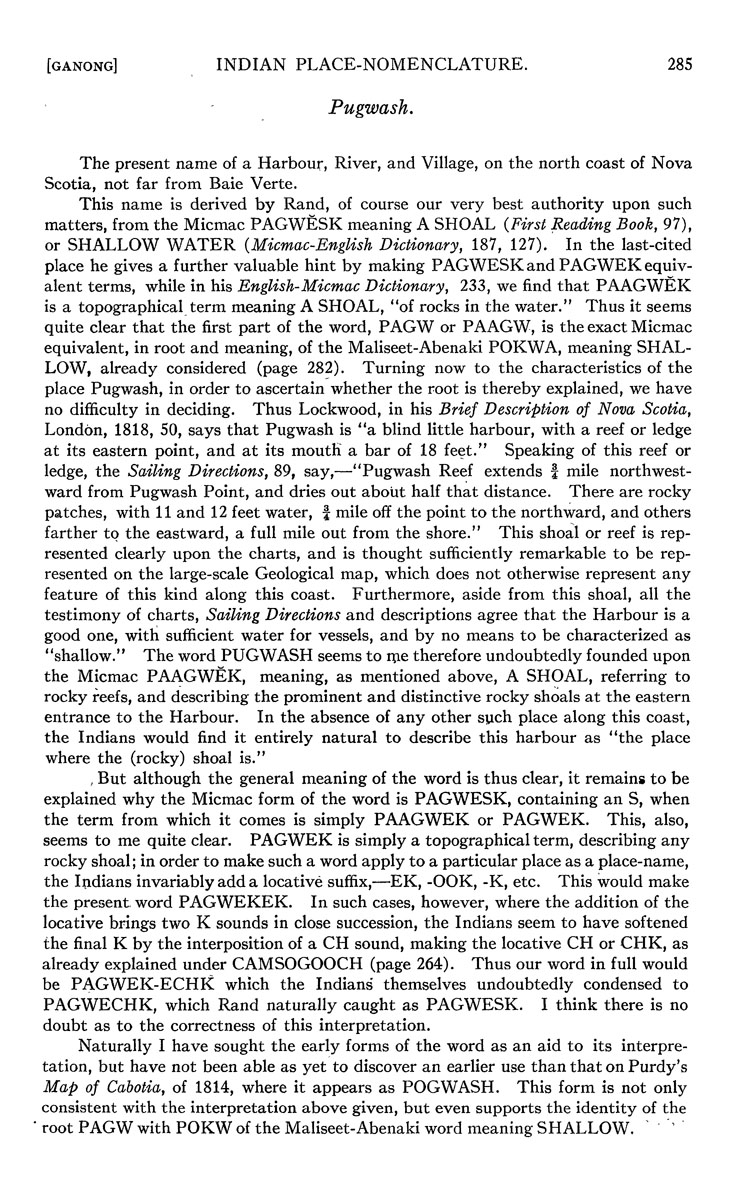[ganong] INDIAN PLACE-NOMENCLATURE. 285
Pugwash,
The present name of a Harbour, River, and Village, on the north coast of Nova
Scotia, not far from Bale Verte.
This name is derived by Rand, of course our very best authority upon such
matters, from the Micmac PAGWESK meaning A SHOAL {First Reading Book, 97),
or SHALLOW WATER {Micmac-English Dictionary, 187, 127). In the last-cited
place he gives a further valuable hint by making PAGWESK and PAGWEK equiv¬
alent terms, while in his English-Micmac Dictionary, 233, we find that PAAGWEK
is a topographical term meaning A SHOAL, "of rocks in the water." Thus it seems
quite clear that the first part of the word, PAGW or PAAGW, is the exact Micmac
equivalent, in root and meaning, of the Maliseet-Abenaki POKWA, meaning SHAL¬
LOW, already considered (page 282). Turning now to the characteristics of the
place Pugwash, in order to ascertain whether the root is thereby explained, we have
no difficulty in deciding. Thus Lockwood, in his Brief Description of Nova Scotia,
London, 1818, 50, says that Pugwash is "a blind little harbour, with a reef or ledge
at its eastern point, and at its mouth a bar of 18 feet." Speaking of this reef or
ledge, the Sailing Directions, 89, say,—"Pugwash Reef extends | mile northwest¬
ward from Pugwash Point, and dries out about half that distance. There are rocky
patches, with 11 and 12 feet water, J mile off the point to the northward, and others
farther to the eastward, a full mile out from the shore." This shoal or reef is rep¬
resented clearly upon the charts, and is thought sufficiently remarkable to be rep¬
resented on the large-scale Geological map, which does not otherwise represent any
feature of this kind along this coast. Furthermore, aside from this shoal, all the
testimony of charts. Sailing Directions and descriptions agree that the Harbour is a
good one, with sufficient water for vessels, and by no means to be characterized as
"shallow." The word PUGWASH seems to rp.e therefore undoubtedly founded upon
the Micmac PAAGWEK, meaning, as mentioned above, A SHOAL, referring to
rocky reefs, and describing the prominent and distinctive rocky shoals at the eastern
entrance to the Harbour. In the absence of any other such place along this coast,
the Indians would find it entirely natural to describe this harbour as "the place
where the (rocky) shoal is."
, But although the general meaning of the word is thus clear, it remains to be
explained why the Micmac form of the word is PAGWESK, containing an S, when
the term from which it comes is simply PAAGWEK or PAGWEK. This, also,
seems to me quite clear. PAGWEK is simply a topographical term, describing any
rocky shoal; in order to make such a word apply to a particular place as a place-name,
the Indians invariably add a locative suffix,—EK, -OOK, -K, etc. This would make
the present word PAGWEKEK. In such cases, however, where the addition of the
locative brings two K sounds in close succession, the Indians seem to have softened
the final K by the interposition of a CH sound, making the locative CH or CHK, as
already explained under CAMSOGOOCH (page 264). Thus our word in full would
be PAGWEK-ECHK which the Indians themselves undoubtedly condensed to
PAGWECHK, which Rand naturally caught as PAGWESK. I think there is no
doubt as to the correctness of this interpretation.
Naturally I have sought the early forms of the word as an aid to its interpre¬
tation, but have not been able as yet to discover an earlier use than that on Purdy's
Map of Cabotia, of 1814, where it appears as POGWASH. This form is not only
consistent with the interpretation above given, but even supports the identity of the
■ root PAGW with POKW of the Maliseet-Abenaki word meaning SHALLOW. ^
|








